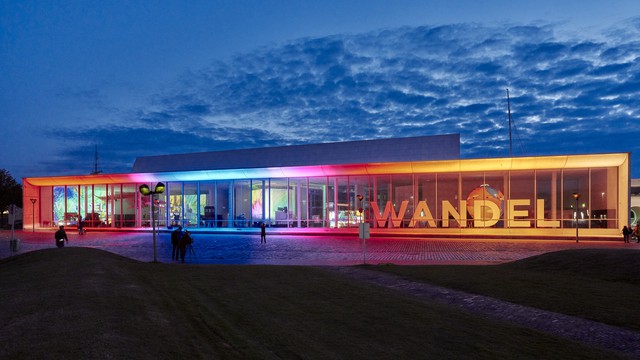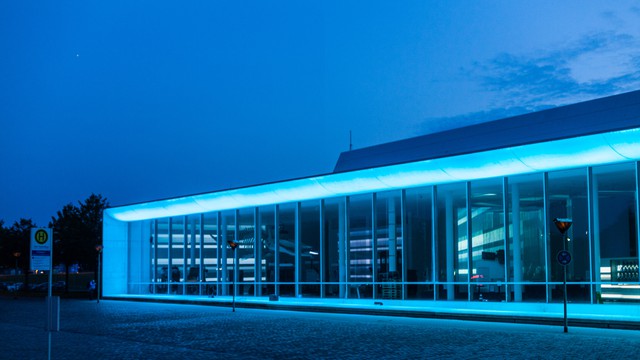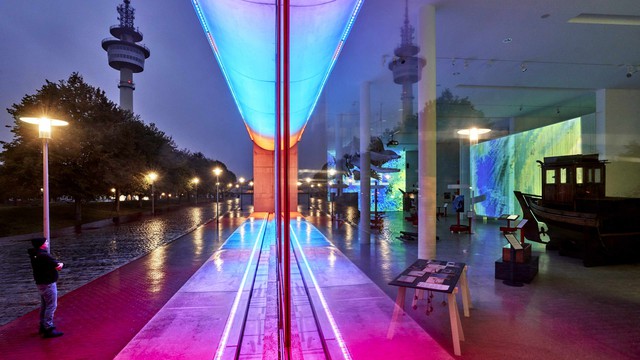Window into the Seas 2020, Germany, Bremerhaven
The Ocean in the City







A ship-sized landmark made of light catches the eye and literally frames an immersive cutout of the oceans – and a view into the German Maritime Museum/Leibniz-Institute for Maritime History. The installation showcases maritime questions of relevance to society as a whole by layering exhibits and multimedia projections. For the 30th anniversary of German unification, Xenorama – Studio for Audiovisual Arts developed an immersive show that emanates from a tidal calculator manufactured in East Germany in 1955 to span the entire facade of the museum and connect the interior projection surfaces to an outer LED frame.
The 75m wide and 6,3m high media facade consists of three elements: the FRAME, the projectors and the speakers. The FRAME is a permanent installation conceived by Helmut Bien (Westermann Kommunikation, Ingelheim), designed by Dirk Mailänder (Cologne) and implemented by LightLife (Cologne) using 98 iGuzzini Linealuce mini 47 LED-bars to illuminate the concrete window frame of the museum. The setup of projectors and sound-equipment – designed by Xenorama – is individually positioned inside the building utilizing the FRAME by a light program synchronized with the projected content. — Scientific Team of the German Maritime Museum/Leibniz-Institute for Maritime History: Prof. Dr. Sunhild Kleingärtner (Managing Director), Prof. Dr. Ruth Schilling (Scientific Head), Dr. Martin Weiss, Jana Beinlich
https://www.dsm.museum/en/press-area/frame-lighting-installation-celebrates-its-premiere
Details
Building or project owner : German Maritime Museum/Leibniz-Institute for Maritime History
Architecture : Dietrich Bangert
Project artist/ concept/ design/ planning : German Maritime Museum | Exhibition Department
Light design : FRAME by Westermann Kommunikation | Helmut M. Bien & mailänder licht design | Dirk Mailänder
Technical layout light : LightLife – Lukas Gössling | Antonius Quodt
Display content/ visuals/ showreel : Xenorama – Marcel Bückner | Tim Heinze | Richard Oeckel | Lorenz Potthast | Moritz Richartz
Light hardware (LED hardware) : 3 x projectors (Panasonic, Sanyo, NEC) | FRAME: 98 x iguzzini Linealuce Mini 47
Lighting control software : Pharos
Project co-ordination : Christoph Geiger, German Maritime Museum/Leibniz-Institute for Maritime History
Interaction design/ programming : vvvv
Project sponsor/ support : Die Senatorin für Wissenschaft und Häfen — Freie Hansestadt Bremen Leibniz Research Museums (Aktionsplan Eine Welt in Bewegung) Support: Hochschule für Künste Bremen – Prof. Roland Lambrette, Hergarten – Interactive Environments, Hamburg
Descriptions
Facade type and geometry (structure) : Large-scale window with concrete framing
Kind of light creation : LED-bars and Projectors
Resolution and transmitting behaviour : indirect illumination
Pixel distance : 20cm
Urban situation : The museum is located in Bremerhaven’s historic Old Harbor, connecting it to the city’s maritime history through both time and space.
Participatory architecture & urban interaction
Community or communities involved : The project provides a stage for content-driven shows that connect the museum’s interior exhibition space with its surrounding public space – even after closing hours. The collaboration of researchers and new media artists translated scientific content into a powerful and memorable audiovisual experience that is easily accessible for a broad audience.
Mediacredits
DSM / Hauke Dressler
Xenorama - Studio for Audiovisual Art
DSM / Hauke Dressler
DSM / Hauke Dressler
Xenorama - Studio for Audiovisual Art
DSM / Hauke Dressler
DSM / Hauke Dressler
xenorama